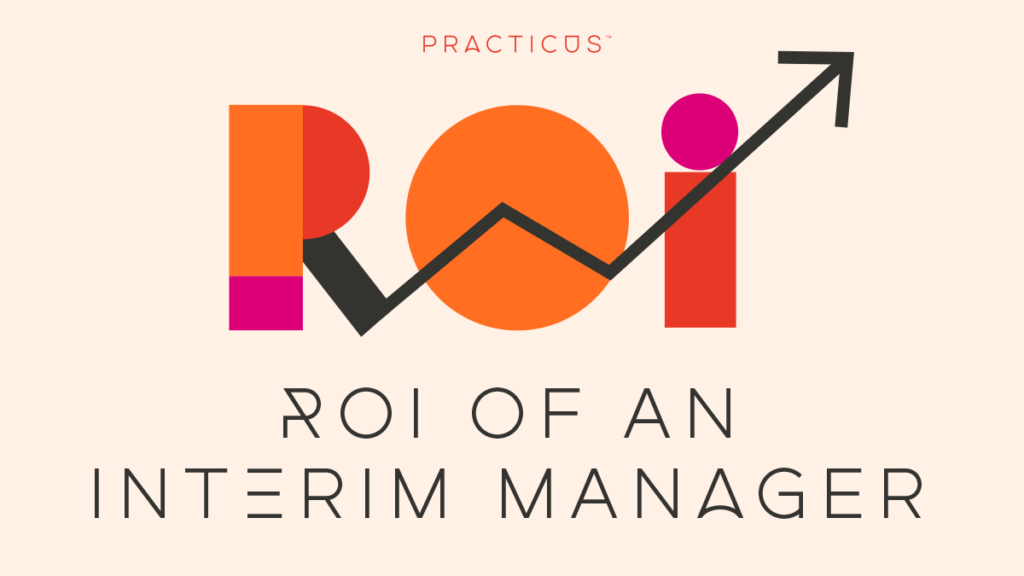ROI of an interim manager

The ROI of an interim manager, conflicting incentives in the hiring process and a bit of a rant about poorly designed recruitment frameworks.
There’s often a tension when hiring between lowering the people costs, which can be considerable at scale, and ensuring the business has the talent it needs. Both of these are a factor when calculating ROI for recruitment. However, the cost element tends to get a lot more attention because its easier to measure. Too often organisations are guilty of overlooking the ‘return’ element of the equation.
This is what leads to tension. Parts of an organisation are motivated to lower annual recruitment costs. Other parts, most notably hiring managers, are incentivised to deliver greater business performance and want the best people. And that can mean paying more.
Both groups have the ultimate aim of driving the bottom line and securing the business’s future. Yet, they can disagree on which is more important when it comes to hiring.
This may seem simplistic given how far HR has matured as a discipline over the last 20 years. But these fundamental mechanics are alive and well in many of today’s organisations. And they are important because they are the reason why the ROI of an interim manager is often overlooked – leading to poor hiring decisions and counterproductive recruitment frameworks.
“Decisions become decidedly more ‘clutch’ the further you move up the organisational hierarchy.”
Calculate based on the context
Often, the competing incentives rub along well enough in general recruitment. But they are thrown into conflict in cases like interim managers.
When hiring new employees in volume, taking a good candidate over a perfect candidate here and there is relatively inconsequential. And there can be significant upside when done at scale if it enables lower agency and salary costs. No-one says the most expensive candidate has to be the best candidate after all.
However, these decisions become decidedly more ‘clutch’ the further you move up the organisational hierarchy. The potential benefits and the potential damage is much greater in scale. Poor leadership and decision-making at higher levels reverberates around the organisation. Whereas good leadership and decision-making is a force multiplier.
In these cases, the lower volume of hiring means that the hiring costs are less important to the overall equation than securing the right talent. It’s not about whether its fair that leaders earn more. It’s just a different calculation because of the gravity of the context.
Missing the point on interim and contract hires
This is partly understood and recognised but not completely. There is a disparity in the market.
While the need to treat Executive Search differently to general recruitment is well understood in most organisations, interim management (the contract equivalent) tends to be lumped in with temporary and contingent labour. For many organisations, it is procured under the same frameworks and is subject to the same evaluation criteria.
And because temporary and contingent labour is bought in high volume – particularly compared to interim management – it’s extremely cost sensitive.
Interim management becomes subject to an evaluation criteria that is overly-weighted around cost at scale. That’s despite being procured in small volume, and typically even smaller than senior permanent hiring and executive search, which are not subject to the same cost calculus.
Interim managers provide a very different value proposition to temporary and contingent labour. And they are used in particular situations where the implications can be just as weighty as the most senior executive hire.
What those lumping interim management in with temp in their frameworks miss is the cost-benefit analysis. They take a lop-sided view on the cost without taking into consideration the value and weight of the context. They miss the ROI of interim managers.
“Often you can quadruple the hiring costs of a good interim manager and still be markedly up on the deal by factors of ten when comparing it to the alternative of denying a multimillion-pound strategic challenge the talent it needs.”
ROI of interim managers
Interim managers tend to be senior – working at or close to board-level. They work on important challenges and projects that cannot wait. And the assignment by definition requires skills and experience that the organisation simply does not have available internally. (See what is an interim manager role)
Now, you could say that the hiring costs of interims are expensive versus a permanent equivalent. We do not believe they are in truth once you factor in the hidden costs (see why interim management is much less costly than you think). But regardless, the hiring costs are still absolutely dwarfed by the risks of selecting a less than perfect candidate.
Often you can quadruple the hiring costs of a good interim manager and still be markedly up on the deal by factors of ten when comparing it to the alternative of denying a multimillion-pound strategic challenge the talent it needs. In these cases, success means securing the organisation’s future plans and ambitions. Getting it wrong can mean millions in budget wasted before you even get to the knock-on financial impact of failure to the business.
In a nutshell, this is the ROI of an interim manager. And it’s a salient point about how the higher up the organisational pyramid you go, the weighting changes significantly between business needs and hiring cost.
That’s not to say the right candidate is always the more expensive candidate. It’s not even to say that ‘higher up’ hiring is more important than volume recruitment. It’s about the difference in impact of getting individual roles right or getting them wrong. Taken individually, some roles have greater impact than others.
Ultimately, it’s about how hiring policy must take into account the hiring context.
“So how do you measure ROI?”
Measuring the ROI of an interim Manager
So how do you measure the ROI? Certainly, there are many soft benefits of an interim manager that can be difficult to quantify. But if you want it bring it down to ‘brass tacks’, the ROI of an interim manager is easier to calculate than it is for many permanent positions.
Because interim assignments are usually project-based, it gives us several important data points prior to hiring. There is an agreed start date, a projected finish date and ‘hard’ deliverables. The advantage here is that they are agreed upfront, meaning you can do the projected calculation in advance. Anything delivered beyond them during the assignment is additional value added.
It is a case of identifying benefits against those deliverables and then quantifying them. Of course, it’s not as easy as just focusing on the cost element. But this is something that most large businesses have to do anyway for important projects and often forms part of the business case. In short, you may already have most of the calculations and projections you need and there’s no reason you cannot use them when hiring.
Even if you don’t, the formulas for the ROI of an interim manager are simple. Perhaps the simplest is outlined below:
Interim Manager ROI = 100 x (financial benefit – cost)/cost
(ROI is expressed as a % so for ease ‘100 x’ is added to the equation)
a = all the directly attributable net financial benefit arising from the interim assignment
b = the cost of the assignment pertaining to the interim, e.g. day rate and any related fees
The ROI calculation is:
ROI = 100 x (a-b)/b
(ROI is expressed as a % so for ease ‘100 x’ is added to the equation above)
Plug in some reasonable numbers and have a play around. You will see that the cost of any candidate makes relatively little difference versus the level of confidence you have in a candidate’s ability to achieve the deliverables and therefore the financial benefit.
Consequently, £100 in day rate here or there is not going to make the difference but the risk of a sub-quality candidate absolutely will. In fact, it can ultimately cost in the millions.
Get in touch
Ensure your hiring calculations do not ultimately hobble your end goals. Get in touch today for support with a balanced approach to hiring ROI.

Sam Hawkins
Director
N.B. ‘hard’ benefits are easy to put into this ROI of an interim calculation. But in terms of ‘soft’ savings and benefits that are not so easy to quantify financially, there are a range of methods you can use. We recommend Mary Ruff’s article on Soft and Hard savings, what counts can be counted1.
Other interim manager articles
Interim managers have been a growing presence in the workplace since the 1970s. Now worth over £1bn, the market for interim managers is dynamic, constantly evolving and changing. If you want to know more about interim management, we have further resources on the following pages:
- Interim management skills needed
- What is an interim manager?
- Interim manager meaning
- What is an interim manager role?
- Executive interim management
- What benefits interim manager?
- Interim Management Client Guide
- Interim Management Candidate Guide
- Interim management in a time of COVID-19
- IR35, what it means for Interim Managers
About Practicus
Practicus is one of the leading interim management agencies and you can find out more about us on the about us page.
References
- Hard and soft savings, what counts can be counted, Mary Ruff, isixsigma.com